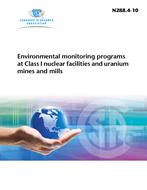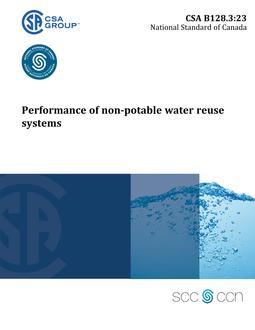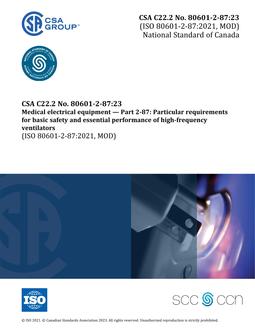
CSA N288.4-10 (R2015)
Click here to purchase
Preface
This is the second edition of CSA N288.4, Environmental monitoring programs at Class I nuclear facilities and uranium mines and mills. It supersedes the first edition, published in 1990 under the title Guidelines for Radiological Monitoring of the Environment. It is part of a series of Standards and Guidelines on environmental management for nuclear facilities.
Scope
1.1 Facilities
1.1.1 Types of facilities
1.1.1.1
This Standard addresses the design and operation of EMPs for Class I nuclear facilities and uranium mines and mills. These facilities include
(a) nuclear reactors;
(b) uranium mines, mills, refineries, and conversion plants;
(c) uranium fuel fabrication plants;
(d) isotope-processing facilities;
(e) particle accelerators; and
(f) waste-management facilities.
1.1.1.2
Parts of this Standard could also be relevant to the design and operation of EMPs for
(a) Class II nuclear facilities;
(b) institutions operating under the authority of a nuclear substances and radiation devices licence; and
(c) facilities that use or store naturally occurring radioactive materials.However, in these situations, the operator of the facility or institution is responsible for determining the applicability and suitability of the guidance.The monitoring described in this Standard could also be applicable to low-level emissions of nuclear and hazardous substances released to the environment due to existing exposure situations such as those resulting from the contamination of areas with radioactive materials produced or used in past activities.However, in these cases, the operator of the facility is responsible for determining the applicability of the guidance.
1.1.2 Monitoring program boundary This Standard addresses monitoring conducted in the environment within the spatial boundaries defined in the ERA. This monitoring starts beyond
(a) the final point of control for an airborne or waterborne release; or
(b) the facility boundary (which may be the outer wall or foundation of the building housing the licensed activity or the boundary of the protected area as defined in Section 9 of the Nuclear Security Regulations for nuclear facilities to which those Regulations apply).
The monitoring extends out to locations determined in the ERA by receptors and receptor range.
Notes:
(1) This Standard does not address effluent monitoring, which involves the monitoring of the release of nuclear andhazardous substances to the environment.
(2) This Standard assumes that the exposure to nuclear substances or hazardous substances of persons working or visiting inside the facility boundary will be controlled through the facility radiation protection program, environmental protection program, or health and safety program.
1.1.3 Facility lifecycle
The nature and extent of environmental monitoring requirements will change during the lifecycle of the facility. This Standard addresses monitoring performed during
(a) site preparation, construction, and commissioning;
(b) operations;
(c) decommissioning; and
(d) any period of institutional control that might follow closure of the facility.
Baseline monitoring occurs prior to the submission of an application for a licence to prepare a site. Data from baseline monitoring are generally used as an input into the ERA. This Standard does not address pre-licensing baseline monitoring. However, many of the recommendations and considerations providedwithin this Standard are applicable to environmental baseline activities. In addition, pre-licensing baseline data collection should place special emphasis on environmental factors and elements that might be carried forward to the EMP.
Note: See CNSC RD-346 for more information on pre-licensing baseline monitoring.
1.2 Operating conditions
The monitoring described in this Standard is applicable where human and/or non-human biota might routinely be exposed to (a) low-level emissions of nuclear and hazardous substances released to the environment as the result of the normal operation of a nuclear facility; or
(b) physical stressors imposed on the environment as the result of the normal operation of a nuclearfacility.
This Standard does not address acute or high-level exposures that can result from accident scenarios, although some parts of this Standard might be applicable to the monitoring of the long-term effect of such an event. In these cases, the operator of the facility is responsible for determining the applicability of the guidance.
1.3 Contaminants and physical stressors
This document provides guidance on monitoring for the contaminants and physical stressors in environmental media, as identified in the ERA and/or in the statutes, regulations, licenses, and permits that govern the operation of the facility. These contaminants and physical stressors can include one or more of the following:
(a) hazardous substances such as toxic, corrosive, or environmentally deleterious substances;
(b) nuclear substances and radiation; and
(c) physical stressors such as heat and noise.
1.4 Receptors and biological effects
1.4.1
This document provides guidance on designing an EMP that can
(a) measure direct biological effects on receptors; and
(b) provide the data necessary to assess potential biological effects on receptors.
Note: Measurements of effects in non-human biota (measurement endpoints) can occur at the level of an individual organism, a population, or a community. Often measurement endpoints at the individual level are intended to represent the potential for higher level effects (assessment endpoints) that are of primary concern to environment managers.
1.4.2
Receptors should be identified in the ERA and/or in the statutes, regulations, licences, and permits that govern the operation of the facility. The receptors can include human or non-human biota.
1.5 Interpretation of data
This Standard provides guidance on the interpretation of data collected by an EMP. However, users are cautioned that the statutes, regulations, licences, and permits that govern the operation of the nuclear facility can impose requirements regarding data analysis and interpretation that differ from those described in this Standard. The operator of the nuclear facility is responsible for determining what data analysis and interpretation are necessary to ensure compliance with the statutes, regulations, licences, or permits that govern the operation of the nuclear facility.
1.6 Dose assessment
Although one of the objectives of an EMP may be to provide the data required to support radiation dose assessments or assessments of exposure to non-radioactive hazardous substances, this document does not address dose assessment methods for either human or non-human biota.
Note: Assessments of dose/exposure are normally part of the ERA and any subsequent assessments based on environmental monitoring data should be done the same way, using the same standards and guidance that were used in the ERA or their most recent updates. Monitoring to support dose assessment is further addressed in Clause 7.5.
1.7 Reporting
This Standard provides guidance on reporting the results of an EMP. However, users are cautioned that the statutes, regulations, licences, and permits that govern the operation of the nuclear facility may impose reporting requirements that differ from those described in this Standard. The operator of the nuclear facility is responsible for determining the required frequency and content of reports to regulatory agencies necessary to ensure compliance with the statutes, regulations, licences, or permits that govern the operation of the nuclear facility.
1.8 Terminology
In CSA Standards, “shall” is used to express a requirement, i.e., a provision that the user is obliged to satisfy in order to comply with the standard; “should” is used to express a recommendation or that which is advised but not required; and “may” is used to express an option or that which is permissible within the limits of the standard.
Notes accompanying clauses do not include requirements or alternative requirements; the purpose of a note accompanying a clause is to separate from the text explanatory or informative material.
Notes to tables and figures are considered part of the table or figure and may be written as requirements.Annexes are designated normative (mandatory) or informative (non-mandatory) to define their application.
Product Details
- Edition:
- 2nd
- Published:
- 05/01/2010
- ISBN(s):
- 9781554913954
- Number of Pages:
- 132
- File Size:
- 1 file , 4.2 MB
- Product Code(s):
- 2420613, 2420612, 2420612


